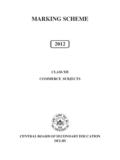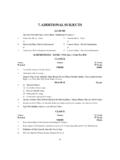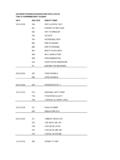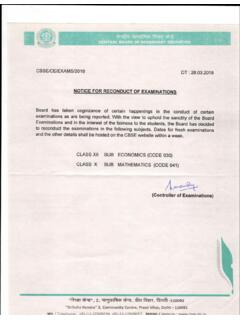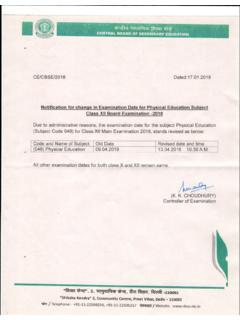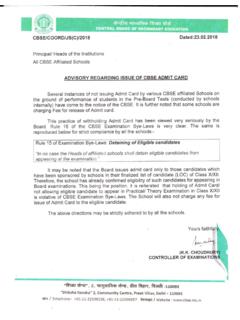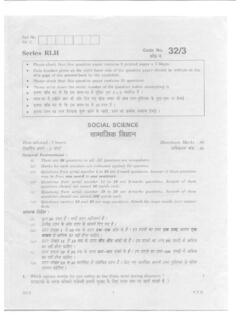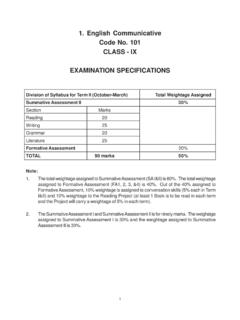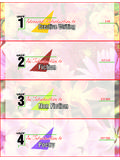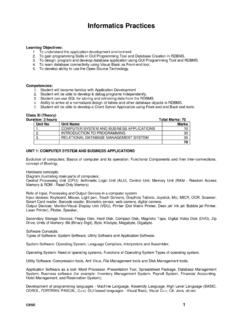Transcription of CENTRAL BOARD OF SECONDARY EDUCATION: DELHI
1 CENTRAL BOARD OF SECONDARY education : DELHI . PRESS NOTE. 20th May, 2014. RESULTS SECONDARY SCHOOL EXAMINATION (CLASS X), 2014. Duration of Examination : 1st March 2014 to 19th March 2014 (Scheme II). 10th March 2014 to 31st March 2014 (Scheme I). Date of result declaration : 19 th May, 2014 (Chennai and Thiruvananthapuram). 20 th May 2014 (Allahabad, Ajmer, Bhubaneshwar, DELHI , Patna, Guwahati, Panchkula, Dehradun). RESULT STATISTICS :- In total 1327250 candidates were registered for class X examination this year. This amounts for an increase of about % candidates over that of last year. HIGHLIGHTS( All Regions):- Percentage of candidates Qualified for admission in Higher Classes in 2013 = Percentage of candidates Qualified for admission in Higher Classes in 2014 = Girls do better than boys. Percentage of girls qualified for admission in higher classes is as compared to that of boys which is Over all percentage of candidates qualified for admission in higher classes in Thiruvananthapuram Region is which is the highest as compared to other regions.
2 * The CBSE has been able to declare the result before time for Class X. because of introduction of On-Screen Marking. Page: 1. SECONDARY SCHOOL EXAM (CLASS X) RESULT-2014. PRESS NOTE. HIGHLIGHTS FOR CLASS X 2014 EXAMINATIONS. This year the BOARD introduced the facility for the schools to generate online Roll number wise List of Candidates appearing in Class X examination. Schools also generated online Admit cards for the regular students appearing in 2014. On-Screen Marking (OSM) system is first National examination body to have started On Screen Marking (OSM). This system was introduced in the class X exams in all subjects and for all regions except Thiruvananthapuram. However, in Class XII OSM was done in English (core) and Economics in DELHI region only. This move is designed to help in strengthening the evaluation process and minimizing the scope for errors. Teachers from affiliated schools were trained for On Screen Marking. Answer-books for these subjects were scanned and uploaded centrally and then downloaded at the evaluation centres online.
3 For evaluation, teachers were given a user-id through which they could access and download the batch of scripts assigned to them for evaluation. The OSM software has been developed in such a way that the Answer book cannot be submitted to the Head Examiner if there is any un- assessed portion or unmarked answer on the Answer books. As a result there is no chance of leaving questions unassessed. The Head Examiner was responsible for reviewing 10% Answer books compulsorily to ensure proper marking and rectifying mistakes, if any. Continuous and Comprehensive Evaluation (CCE). The CCE scheme is one of the flagship programmes of the BOARD which has been implemented for students upto SECONDARY level, in all CBSE. affiliated schools. CCE envisages conceptual clarification through experiential learning in classrooms. The entire assessment consists of three parts: Part I: Scholastic Areas, Part II: Co-Scholastic Areas such as Life Skills, Work education , Visual and Performing Arts, Attitudes and Values, Part III Co- Scholastic Activities such as Literary and Creative Skills, Scientific Skills, Information and Technology, Organizational and Leadership Skills, Health and Physical Activities, Sports etc.
4 Page: 2. Each academic year is divided into two terms consisting of 4. Formative (FAs) and 2 Summative Assessment (SA) in classes IX & X. First Term : FA1 (10%) + FA2 (10%) +SA1 (30%) = 50%. Second Term : FA3 (10%) + FA4/PSA (10%) + SA2 (30%) = 50%. FA4 has been replaced by Problem Solving Assessment (PSA) in the subjects of one language (English/Hindi), Science, Maths & Social Science. Assessment in Speaking and Listening Skills (ASL) in English was introduced for10 marks have been held in both the SA's and grade obtained are being shown separately in the Gradesheet cum Certificate of Performance. The Scheme of examination under the Continuous and Comprehensive Evaluation (CCE) Class X 2014: I Scheme 1 No BOARD Examination at SECONDARY (Class X) level for students studying in the schools affiliated to the BOARD who did not wish to move out of the CBSE system after Class X. Every School, Sahodaya Cluster or City designed its own date sheet for classes IX and X School Based Examination accordingly.
5 Schools conducted the examination from to The BOARD had sent the Question Papers online for Classes IX and X. (Scheme-I) for Summative Assessment-II through Integrated Test Management System (ITMS). Each school had to register on CBSE. website with school name a user name and password to receive question papers. II Scheme 2 Students of schools affiliated to the BOARD who wished to move out of the CBSE system after Class X (Pre-University, Vocational course, Change of BOARD etc.) were required to take the BOARD 's external examination at SECONDARY (Class X) level. Question papers and Marking Schemes were prepared by the CBSE and evaluation carried out by the BOARD through external examiners. Examination commenced from 1st March, 2014 and concluded on 19th March, 2014. Certification by the BOARD -A uniform certificate is being issued to all the candidates by the BOARD , whether appeared under Scheme-I or Scheme-II. Page: 3. Collection of Assessment Data of Students- Schools were asked to upload total Class IX and Class-X Formative & Summative Assessment marks for which downloadable software was provided by the BOARD .
6 Problem Solving Assessment has been introduced for the students of Classes IX and XI with the objective of assessing students' higher order thinking skills. It is compulsory for all students of classes IX and XI. PSA comprises of 60 MCQ of 60 marks based on Language conventions, Qualitative Reasoning and Quantitative Reasoning. There is no specific syllabus for the test. PSA assesses student's ability to process, interpret and use information rather than assessing students prior subject knowledge. PSA score is counted towards FA4 which is 10% of total assessments for class-IX. This score is reflected equally in one language (English or Hindi), Mathematics, Science and Social Science. Class-XI students are issued a separate certificate for the same. Improvement in PSA All those students of classes X (who appeared in PSA while studying in classes IX during the previous session) and who wished to improve in PSA were allowed to do so. Value Based Questions were introduced in SA-II in all major subjects for classes IX and X.
7 The BOARD decided to follow an interdisciplinary approach in value education where values are intermingled with the content of all the major subjects in classes IX to XII. The questions up to 3-5 marks were based on content and analysed on the basis of the values it reflects. National Vocational education Qualifications Framework CBSE has introduced four vocational subjects namely Dynamics of Retailing, Automobile Technology, Information Technology and Security in selective schools from the session 2012-13 from class IX onwards. The first batch of class X appeared in 2014 examinations. Schools opted one vocational subject either as compulsory or additional subject. The syllabus for the core subjects of Mathematics, Science, Hindi, English and Social Science was rationalized for those who opted these subjects as compulsory. The formative assessment was carried out as per CCE norms. In Summative Assessment I and SA-II, the distribution of marks between theory and practical was 30:60.
8 In respect of candidates who have taken one of the subject under vocational as compulsory, the CGPA has been calculated out of six subjects. Joint certification of skills: In order to assess the skills experts will be nominated by the respective Sector Skills Council (bodies of Page: 4. industries) for the purpose of issuing joint certificate with the Sector Skills Council. Students Global aptitude Index Ce n t ra l B oa rd of Se con da r y Ed u ca ti on i s th e fi r st Boa r d i n th e cou n try t o i nt rod u ce t he con ce p t of a p t it u de a sse ssme n t i n 2 0 1 1 . The purpose of CBSE SGAI is primarily to help the larger population including parents, teachers and students to initiate a dialogue on subject choices that lead to effective career planning later in life. T he CB S E SG AI i s op ti on a l a ctiv i t y me a n t f or cla s s X. stu d e n ts for st ude n t s st ud yi n g i n CB S E a f f i li a t e d sch ool s a cross t he worl d . It is aimed to indicate aptitude , interest and Motivation of a student in order to facilitate a student with his/her subject preferences.
9 More than 6 Lac students from approximately 10,000 schools across the globe have participated in four editions of SGAI conducted so far. Himachal Pradesh BOARD of School education has also partnered with CBSE and conducted SGAI. Observation Schedules: To give fair deal to the question papers administered under Scheme II and redress genuine grievances of the students, observation schedules were sent to all the schools to record and forward their suggestions within 24 hours of the conduct of examination in concerned subject so that those could be considered by the expert group while preparing the marking schemes. Concessions to Special Category Students As per Bye-laws of the BOARD and as defined in the Persons with Disabilities Act, 1995, the BOARD extends a number of relaxations to special candidates. Exemptions given to Spastic, Visually Impaired candidates, Physically Handicapped, Autistic, Dyslexic and candidates with disabilities as defined in the Persons with Disabilities Act, 1995:- 1.
10 Exemption from studying third language up to middle school level ( Class VIII);. 2. At SECONDARY School level a candidate has an option to opt for one language and any four of the following electives. Mathematics, Science, Social Science, Another Language, Music, Painting, Home Science, Foundation of Information Technology, Commerce (Elements of Commerce) and Commerce (Elements of Book Keeping and Accountancy). Page: 5. 3. permission to use a scribe;. 4. the scribe must be a student of class lower than the one for which the candidate will be taking the examination;. 5. the Centre Superintendent of the Examination Centre chooses a suitable scribe and forwards his/her particulars to the Regional Officer concerned for consideration and approval;. 6. the services of scribe are provided free of cost;. 7. the scribe is paid remuneration as prescribed from time to time by the BOARD , which at present is per day;. 8. the candidate may be permitted to use the services of a scribe in all or any of the papers.
